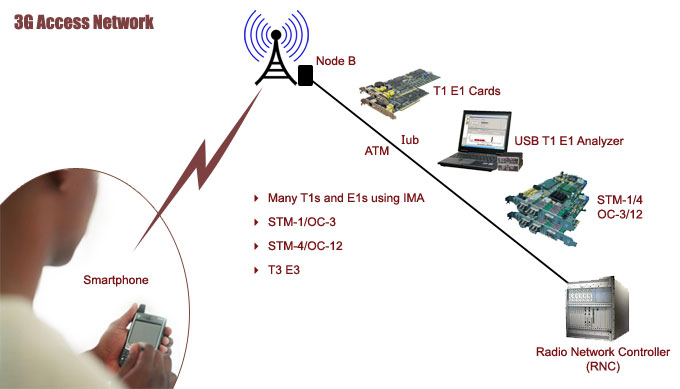Newsletter: GL Announces Analysis Tools for 3G Mobile Broadband Networks
Welcome to another March 2010 issue of GL's Newsletter providing information on our analysis tools for 3G Mobile Broadband networks. Mobile network traffic due to 3G is expected to explode in the coming year as "smartphones" pervade the mobile user community. 3G, 4G, UMTS - the terminology gets quite confusing, let's try to wade thru the acronyms before discussing 3G test equipment:
- 4G - or 4th Generation, also called LTE, or Long Term Evolution, proposes very high throughput, 100 Mbps and greater mobile radio access and an all IP core network. It's not here yet.
- 3G - or 3rd Generation is essentially the umbrella term for broadband mobile technologies. It is often used with the term UMTS, which is a specific and most widespread implementation of 3G. 3G also includes GSM Edge, CDMA 2000, WIMAX, and other broadband mobile technologies. The two leading 3G systems are UMTS and CDMA 2000. UMTS is closely allied to worldwide GSM and CDMA 2000 is closely allied to Qualcomm and Verizon. Of course, the demand for broadband at the handset is creating frequency congestion and greater demand for frequency allocation for this purpose.
- UMTS - is a specific set of 3G standards that covers the entire mobile system - radio access and the core network. Remember that a mobile network consists of radio access and a core network. The most common form of radio access within UMTS is WCDMA.
- WCDMA - or wideband CDMA is the most common radio access technique used within UMTS, but there are others, for example TD-SCDMA is used in China and is similar to WCDMA. WCDMA uses a pair of 5 MHz wide radio channels to achieve the high bandwidth. ATT uses WCDMA.
In this newsletter, the terminology used is that of the UMTS/WCDMA system. We will leave the competing 3G system of CDMA 2000 for another upcoming newsletter, but the concepts are very similar.
In a typical 3G access network, a "smartphone" user has high speed wireless access to the nearest base station (or Node B, in 3G UMTS terminology). Then the transport of voice, video, and data is thru ATM (Asynchronous Transfer Mode). ATM was selected because it provides quality of service necessary for voice but can also carry data equally well.

ATM can use any form of transmission, but its overhead is quite a burden. If the access network is not carefully designed, ATM bandwidth requirements will significantly affect the bottom line of any service provider. Tools for traffic and protocol analysis are essential.
As shown above, when the underlying transmission is TDM, many T1s or E1s are used to carry ATM cells in a technique called Inverse Multiplexing over ATM, or IMA. If the underlying transmission is T3 E3 or SONET SDH, then ATM can be carried directly in an unchannelized mode, which is more efficient. It may be necessary to switch ATM cells from lower speed E1s (possibly in IMA mode) to an unchannelized STM1 or STM4 for traffic concentration and better efficiency. In any case, it is apparent that testing and analysis of ATM traffic is useful on many interfaces including T1, E1, T3, E3, OC3, OC12, STM1, and STM4. Proper tools will assist in the design of the access network and appropriate backhaul architectures.
GL has developed various test capability to test and analyze ATM over different transmission. These include:
- the ability to capture and playback at up to OC-12/STM-4 rates with complete bit integrity
- raw transmission and reception of test cell traffic at determined bandwidth
- UMTS Protocol Analysis STM1, STM4, OC3, and OC12
- ATM Protocol Analysis over T1 E1 with IMA
- ATM Protocol Analysis over T3
- ATM Protocol Analysis over STM1, STM4, OC3, and OC12
- ATM Tx/Rx Raw Cells
- ATM BERT for OC3, OC12, STM1, and STM4
- ATM Record Playback for T1, E1, T3, OC3, OC12, STM1, and STM4
- UMTS Protocol Analysis
- CDMA 2000 Protocol Analyzer
 Back to Latest News Page
Back to Latest News Page